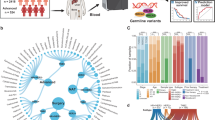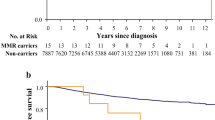Abstract
Background
Germinal center-associated nuclear protein (GANP) is a phosphoprotein involved in mRNA export and regulation of DNA recombination. Although GANP expression in human breast cancer tissue is associated with breast cancer prognosis, the association between the genetic background of GANP and susceptibility and prognosis of breast cancer is unclear.
Methods
We selected 694 breast cancer cases and 1376 age- and menopausal status-matched non-cancer controls from the Hospitable-based Epidemiologic Research Program, conducted at Aichi Cancer Center between 2001 and 2005. We evaluated the impact of two polymorphisms at the GANP locus (rs2839178 and rs11702450) on the susceptibility and prognosis of breast cancer. Reference alleles were defined as the A allele for rs2839178 and G allele for rs11702450.
Results
The GG genotype of rs2839178 was statistically significantly associated with breast cancer risk (odds ratio [OR] 0.48, 95% confidence interval [CI] 0.30–0.76, P = 0.002). In prognostic analysis, compared to those with AA genotype of rs2839178, patients with AG or GG genotypes had longer disease-free survival (DFS) (hazard ratio [HR] 0.71, 95% CI 0.49–1.04 and HR 0.42, 95% CI 013–1.42, respectively, P for trend = 0.04). eQTL analysis indicated that association with rs2839178 can be explained by the effect of rs2839173 on expression of GANP/MCM3AP.
Conclusions
The G allele of rs2839178 at the GANP locus was significantly associated with reduced breast cancer risk and longer DFS in breast cancer patients, showing a consistent direction in the association between susceptibility and clinical outcome. GANP is, therefore, important for the occurrence and progression of sporadic breast cancer.


Similar content being viewed by others
References
International Agency for Research on Cancer. GLOBOCAN, World Health Organization, vol. 2017. http://globocan.iarc.fr/old/FactSheets/cancers/breast-new.asp. Accessed 6 Aug 2018.
Kelsey JL, Gammon MD, John EM. Reproductive factors and breast cancer. Epidemiol Rev. 1993;15(1):36–47.
Taira N, Arai M, Ikeda M, Iwasaki M, Okamura H, Takamatsu K, Nomura T, Yamamoto S, Ito Y, Mukai H. The Japanese Breast Cancer Society clinical practice guidelines for epidemiology and prevention of breast cancer, 2015 edition. Breast Cancer. 2016;23(3):343–56. https://doi.org/10.1007/s12282-016-0673-8.
Miki Y, Swensen J, Shattuck-Eidens D, Futreal PA, Harshman K, Tavtigian S, Liu Q, Cochran C, Bennett LM, Ding W, et al. A strong candidate for the breast and ovarian cancer susceptibility gene BRCA1. Science. 1994;266(5182):66–71.
Wooster R, Bignell G, Lancaster J, Swift S, Seal S, Mangion J, Collins N, Gregory S, Gumbs C, Micklem G. Identification of the breast cancer susceptibility gene BRCA2. Nature. 1995;378(6559):789–92. https://doi.org/10.1038/378789a0.
Kuwahara K, Yoshida M, Kondo E, Sakata A, Watanabe Y, Abe E, Kouno Y, Tomiyasu S, Fujimura S, Tokuhisa T, Kimura H, Ezaki T, Sakaguchi N. A novel nuclear phosphoprotein, GANP, is up-regulated in centrocytes of the germinal center and associated with MCM3, a protein essential for DNA replication. Blood. 2000;95(7):2321–8.
Okamoto N, Kuwahara K, Ohta K, Kitabatake M, Takagi K, Mizuta H, Kondo E, Sakaguchi N. Germinal center-associated nuclear protein (GANP) is involved in mRNA export of Shugoshin-1 required for centromere cohesion and in sister-chromatid exchange. Genes Cells. 2010;15(5):471–84. https://doi.org/10.1111/j.1365-2443.2010.01396.x.
Ohta K, Kuwahara K, Zhang Z, Makino K, Komohara Y, Nakamura H, Kuratsu J, Sakaguchi N. Decreased expression of germinal center-associated nuclear protein is involved in chromosomal instability in malignant gliomas. Cancer Sci. 2009;100(11):2069–76. https://doi.org/10.1111/j.1349-7006.2009.01293.x.
Fujimura S, Xing Y, Takeya M, Yamashita Y, Ohshima K, Kuwahara K, Sakaguchi N. Increased expression of germinal center-associated nuclear protein RNA-primase is associated with lymphomagenesis. Cancer Res. 2005;65(13):5925–34. https://doi.org/10.1158/0008-5472.CAN-04-3259.
Kageshita T, Kuwahara K, Oka M, Ma D, Ono T, Sakaguchi N. Increased expression of germinal center-associated nuclear protein (GANP) is associated with malignant transformation of melanocytes. J Dermatol Sci. 2006;42(1):55–63. https://doi.org/10.1016/j.jdermsci.2005.12.007.
Chan-On W, Kuwahara K, Kobayashi N, Ohta K, Shimasaki T, Sripa B, Leelayuwat C, Sakaguchi N. Cholangiocarcinomas associated with long-term inflammation express the activation-induced cytidine deaminase and germinal center-associated nuclear protein involved in immunoglobulin V-region diversification. Int J Oncol. 2009;35(2):287–95.
Kuwahara K, Yamamoto-Ibusuki M, Zhang Z, Phimsen S, Gondo N, Yamashita H, Takeo T, Nakagata N, Yamashita D, Fukushima Y, Yamamoto Y, Iwata H, Saya H, Kondo E, Matsuo K, Takeya M, Iwase H, Sakaguchi N. GANP protein encoded on human chromosome 21/mouse chromosome 10 is associated with resistance to mammary tumor development. Cancer Sci. 2016. https://doi.org/10.1111/cas.12883.
Yoshida M, Kuwahara K, Shimasaki T, Nakagata N, Matsuoka M, Sakaguchi N. GANP suppresses DNA recombination, measured by direct-repeat beta-galactosidase gene construct, but does not suppress the type of recombination applying to immunoglobulin genes in mammalian cells. Genes Cells. 2007;12(10):1205–13. https://doi.org/10.1111/j.1365-2443.2007.01119.x.
Sueta A, Ito H, Kawase T, Hirose K, Hosono S, Yatabe Y, Tajima K, Tanaka H, Iwata H, Iwase H, Matsuo K. A genetic risk predictor for breast cancer using a combination of low-penetrance polymorphisms in a Japanese population. Breast Cancer Res Treat. 2012;132(2):711–21. https://doi.org/10.1007/s10549-011-1904-5.
Hamajima N, Matsuo K, Saito T, Hirose K, Inoue M, Takezaki T, Kuroishi T, Tajima K. Gene-environment Interactions and Polymorphism Studies of Cancer Risk in the Hospital-based Epidemiologic Research Program at Aichi Cancer Center II (HERPACC-II). Asian Pac J Cancer Prev. 2001;2(2):99–107.
Tajima K, Hirose K, Inoue M, Takezaki T, Hamajima N, Kuroishi T. A Model of Practical Cancer Prevention for Out-patients Visiting a Hospital: the Hospital-based Epidemiologic Research Program at Aichi Cancer Center (HERPACC). Asian Pac J Cancer Prev. 2000;1(1):35–47.
Inoue M, Tajima K, Hirose K, Hamajima N, Takezaki T, Kuroishi T, Tominaga S. Epidemiological features of first-visit outpatients in Japan: comparison with general population and variation by sex, age, and season. J Clin Epidemiol. 1997;50(1):69–77.
Ministry of Health, Labour and Welfare, Japan. Physical activity for promoting health. https://www.mhlw.go.jp/www1/topics/kenko21_11/b2.html. Accessed 2 Nov 2018.
Kawakita D, Oze I, Hosono S, Ito H, Watanabe M, Yatabe Y, Hasegawa Y, Murakami S, Tanaka H, Matsuo K. Prognostic value of drinking status and aldehyde dehydrogenase 2 polymorphism in patients with head and neck squamous cell carcinoma. J Epidemiol. 2016;26(6):292–9. https://doi.org/10.2188/jea.JE20140240.
Gonzalez-Aguilera C, Tous C, Gomez-Gonzalez B, Huertas P, Luna R, Aguilera A. The THP1-SAC3-SUS1-CDC31 complex works in transcription elongation-mRNA export preventing RNA-mediated genome instability. Mol Biol Cell. 2008;19(10):4310–8. https://doi.org/10.1091/mbc.E08-04-0355.
Jani D, Lutz S, Hurt E, Laskey RA, Stewart M, Wickramasinghe VO. Functional and structural characterization of the mammalian TREX-2 complex that links transcription with nuclear messenger RNA export. Nucleic Acids Res. 2012;40(10):4562–73. https://doi.org/10.1093/nar/gks059.
Bhatia V, Barroso SI, Garcia-Rubio ML, Tumini E, Herrera-Moyano E, Aguilera A. BRCA2 prevents R-loop accumulation and associates with TREX-2 mRNA export factor PCID2. Nature. 2014;511(7509):362–5. https://doi.org/10.1038/nature13374.
Zhang B, Chen MY, Sheng YJ, Zhuo XB, Gao P, Zhou FS, Liang B, Zu J, Zhang Q, Suleman S, Xu YH, Xu MG, Xu JK, Liu CC, Giannareas N, Xia JH, Zhao Y, Huang ZL, Yang Z, Cheng H, Li N, Hong YY, Li W, Zhang MJ, Yu KD, Li G, Sun MH, Chen ZD, Wei GH, Shao ZM. A large-scale, exome-wide association study of Han Chinese women identifies three novel loci predisposing to breast cancer. Cancer Res. 2018. https://doi.org/10.1158/0008-5472.CAN-17-1721.
1000 Genomes Project, vol. 2018. https://www.ncbi.nlm.nih.gov/variation/tools/1000genomes/. Accessed 6 Aug 2018.
Acknowledgements
We thank the many doctors, nurses, and technical and administrative staff of Aichi Cancer Center Hospital for their daily administration of the HERPACC study.
Funding
This study was funded by a Grant-in-Aid for Scientific Research from the Ministry of Education, Science, Sports, Culture and Technology of Japan (17015018, 15K08792 and 24590776) and by a Grant-in-Aid for Third-Term Comprehensive 10-Year Strategy for Cancer Control from Ministry of Health, Labour and Welfare of Japan, and Japan Agency for Medical Research and Development (15655291).
Author information
Authors and Affiliations
Corresponding author
Ethics declarations
Conflict of interest
Haruru Kotani declares that she has no conflict of interest. Hidemi Ito declares that she has no conflict of interest. Kazuhiko Kuwahara declares that he has no conflict of interest. Kiyotaka Kuzushima declares that he has no conflict of interest. Hiroji Iwata declares that he has no conflict of interest. Nobuyuki Tsunoda declares that he has no conflict of interest. Masato Nagino declares that he has no conflict of interest. Keitaro Matsuo declares that he has no conflict of interest.
Additional information
Publisher’s Note
Springer Nature remains neutral with regard to jurisdictional claims in published maps and institutional affiliations.
Electronic supplementary material
Below is the link to the electronic supplementary material.
12282_2019_956_MOESM1_ESM.tif
Supplementary material 1 Supplementary fig. 1 eQTL box plot of rs2839173 GANP/MCM3AP in normal breast tissue (TIF 1590 KB)
About this article
Cite this article
Kotani, H., Ito, H., Kuwahara, K. et al. Impact of germinal center-associated nuclear protein polymorphisms on breast cancer risk and prognosis in a Japanese population. Breast Cancer 26, 562–572 (2019). https://doi.org/10.1007/s12282-019-00956-5
Received:
Accepted:
Published:
Issue Date:
DOI: https://doi.org/10.1007/s12282-019-00956-5




